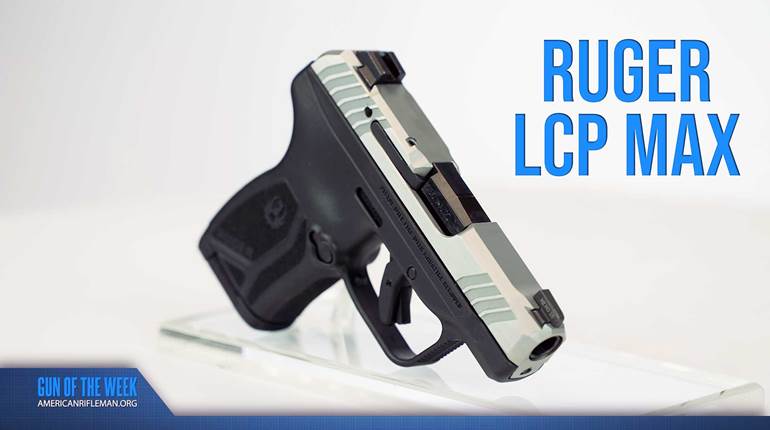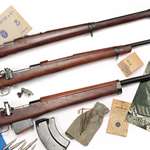
The engineer who sets out to design a new 9 mm Luger semi-automatic pistol faces a daunting task, because it has already been done—and done well. Nevertheless, designers continue to develop new models with marked regularity. In an age of .40s and .45s, you would think that the 9 mm pistol might be in decline. But when I checked with several of the large ammunition manufacturers, they said the No. 1 best-selling pistol caliber is (still) the century-old 9 mm Luger. The cartridge has much to commend it, particularly for a big police agency that must equip and train large numbers of shooters in restricted time frames and with limited resources. The little cartridge is easy to shoot, functions well and performs acceptably, if not ideally, in actual shootings. So it dominates in the market—and so do the guns that shoot it.
Twenty-five years ago, Ruger startled the shooting world when it introduced the 9 mm Luger-chambered P85, its first center-fire semi-automatic. The company regularly updated the concept since it first appeared, but the new SR9 (Sturm, Ruger Nine) is a completely new and different gun. As such, it reflects all the company knows about making commercially competitive pistols and displays the features that the market demands in a cutting-edge service pistol.
The SR9 is a recoil-operated service pistol with a host of features that appeal to today’s handgunners, whether civilian or police. It has a high-capacity, double-column magazine that holds 17 rounds of 9 mm Luger ammunition; another in the chamber brings the on-tap total to a whopping 18 rounds. In order to maintain the gun’s overall weight, Ruger used glass-filled nylon to form a synthetic frame. The SR9 weighs just 26.5 ounces. Lighter pistols—particularly 9 mms—are much in demand, so a synthetic frame is almost a necessity. So is some form of constant-action trigger, with which the length and weight of the pull are the same for each shot. Slide movement is necessary to partially set the internal striker for firing. Complete setting or cocking comes from the initial portion of the trigger pull. Pulling the trigger all the way through completes the cocking and then delivers the shot. It’s the way things are done on the modern semi-automatic.
The Ruger SR9 had a somewhat rocky start, but after a recall and revisions, the gun achieved a reputation for appropriate reliability and innovative design. Ruger recently introduced the SR9c, with “c” standing for compact. To build this newer model, Ruger abbreviated the full-size SR9 in both receiver height and slide length; so a pistol that fit a 7.55- by 5.55-inch box was reduced in size to fit a 6.85- by 4.61-inch one. That is a significantly smaller handgun that has a wider range of deployment options. We will deal with that point in a moment. For now, let’s look at the specifics of the SR9.
Taking the full-size SR9 in hand, we have a sleek pistol with modern curves, planes and angles. It looks good, but the empty gun has an almost top-heavy feel to it. When you add 18 rounds of 9 mm, however, its balance improves. Made with either a brush-finished or blackened stainless steel slide, the SR9 comes with an elevation-adjustable rear sight matched up with a semi-ramp front. The sights have the omnipresent three-dot sight highlights. Viewed from the rear, the aligned sights have a slightly rounded top contour, which I would prefer to see flat. Both of my sample guns had black lowers and stainless uppers, but all-black guns are available, as well as tactical-finish SR9s with black stainless slides and OD-green frames. There is no green SR9c variation.
SR9 slides have design features found on earlier Ruger pistols—most notably, radiused front end profiles and no step at the lower front end of the frame. The Compact has cocking serrations both fore and aft; however, the regular model has them at the rear end of the slide only.
In the molded receiver we see common sense practicality combine with a graceful style to produce a functional, even elegant, semi-automatic pistol. The butt section must house a double-column magazine, as well as provide a functional grip for the shooting hand. On the SR9, the grip is no thicker than it needs to be, but it still provides an expanse of molded-in checkering for a positive grasp. As first seen on the company’s P345 .45 ACP, there is a crescent-shaped depression on the forward edge of each side of the grip. Fingertips just seem to slip right into it, affording a secure grip. At the backstrap, there is a reversible panel to adapt the grip to larger or smaller hands. Better yet, the top of the backstrap is deeply recessed. This positions the web of the hand well into the grip and above the curve of the trigger. The pivoting trigger requires a back-and-up trigger pull. And the closer the hand is to the bore axis of the gun, the better that hand will be able to control recoil. The rear of the trigger guard is rounded and recessed upward, which permits the shooter to get his most powerful gripping finger—the middle one—up high on the grip. Combined with the previously mentioned grip backstrap contour, this high-grip relief contributes to a very controllable gun. I have to believe that the major strength of the SR9 design is its superior ergonomics.
Today’s service semi-automatics customarily have an accessory rail on the dust cover forward of the trigger guard. Most of them are both ugly and awkward, although arguably necessary. On the SR9, the rail is so cleverly worked into the contours of the receiver that the shooter is hardly aware that it’s there.
Finally, look at the magazine floorplate. It’s molded synthetic, but there is a slim little ledge in each side of the bottom. Although nearly unnoticeable, that little ledge is there for a good reason. In the event of a feedway malfunction, the magazine needs to be forcefully ripped out of the gun. That simple little ledge gives the fingers purchase to get it done.
From the advent of the Glock forward, designers have wanted to achieve a safer, simpler, smoother semi-automatic pistol. The mechanical safety of the SR9 pistol comes from several devices. There’s a pivoting trigger safety in the face of the trigger blade and an internal magazine safety. Also, there’s a drop safety that won’t let the striker move without trigger pressure, so a dropped gun can’t fire. Finally, there is an M1911-style (down-to-fire) manual safety on the receiver, just under the pad of the thumb and repeated on the opposite side for southpaws.
The SR9 operating drill is simplicity itself. With an empty pistol, insert a loaded magazine and then retract and release the slide. Press the trigger to fire a shot and repeat as often as necessity demands. To put the gun away in loaded-but-ready status, just pop the manual safety up and holster the gun.
In both big and small versions, the SR9 pistol is primarily a service or defensive firearm. As such, it’s important to look at the gun in terms of how it handles and performs. In size and weight, the original, full-size pistol is close to the average in competing designs. The long 17-round magazines, required because they position the top round at the feed ramp, drop free at a touch of the magazine catch. On the shorter Compact, either the long 17-rounder or the included short 10-rounder will work. This has implications for the police officer who wishes to carry the full-size gun in a duty holster and a second compact SR9 in concealment. The advantage is simply that both guns could be reloaded with the full-size magazines. As a matter of fact, Ruger’s literature states that the SR9c is a “17+1” capacity gun. It comes with one 17-rounder and one 10-round magazine. In the box, you will also find a molded collar that surrounds the bottom end of the 17-round magazine that produces the same butt contour as the SR9 when inserted in the gun. You can use a longer magazine without the collar, as long as you do not violently slam the magazine into the gun. That might risk parts breakage and cause malfunctions. Only in an emergency situation would I use a standard 17-rounder in a Compact.
The Compact comes with a finger-piece extension floorplate for the short 10-round magazine that replaces the flat-bottom floorplate that is standard-issue. Thus we have four different magazines that will work in the Compact: a stock 17-rounder, and one with the collar; and a stock 10-rounder, and one with the fingerpiece extension. In this way the Compact can take on a number or roles. It might be a service gun in a duty holster for a uniformed officer, but the same officer’s off-duty gun when he changes from a long magazine with collar to a short one. There is a great deal of flexibility built into this system.
At a local range, I fired the two pistols in the standard American Rifleman protocol of five consecutive, five-shot groups at 25 yards. Without the proper Ransom Rest inserts, I was forced to shoot over sandbags from a concrete bench. Accuracy was well-within the norm for competing 9 mm designs. However, I must note that I have had much better results with other Ruger pistols, particularly the P345. The trigger has the predictable first stage, during which pressure serves to fully load the striker, followed by a release stage. Both are gritty and have some movement. Although not an easy system to use for great accuracy, for the guns’ intended purpose—self-defense—it’s acceptable.
But this criticism is more than balanced by the gun’s 100 percent reliability and excellent ergonomics. If I were to get the question of which gun is best—among service 9 mms with higher-capacity magazines—for small-handed shooters, the answer is obvious. It is the new Ruger SR9. A slim pistol with an easy-to-manage trigger reach, the SR9 series guns in both sizes are great new semi-automatics for the nation’s handgunners.
Manufacturer: Sturm, Ruger & Co.; (928) 778-6555; www.ruger.com
Caliber: 9 mm Luger
Action Type: recoil-operated, semi-auto center-fire pistol
Frame: glass-filled nylon
Barrel: 4.14”; compact 3.50”
Rifling: six-grove, 1:10” RH twist
Magazine Capacity: 17; compact 10
Sights: fully adjustable, three-dot
Trigger Pull: double-action only; 10 lbs.
Overall Length: 7.55”; compact 6.85”
Width: 1.27”
Height: 5.52”; compact 4.61”
Accessories: lock, lockable hard case, owner’s manual, spare magazine
Suggested Retail Price: $565; compact $525





































